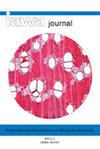干旱诱发栓塞导管直径连接的脆弱性:突破解剖学-生理学的鸿沟
IF 3.5
3区 农林科学
Q2 FORESTRY
引用次数: 3
摘要
对生物体形态和功能之间关系的最佳解释——科学家们认为是最可靠的——总是考虑到跨物种的比较模式以及实验结果。在所有生物学中都是如此,研究木质部结构与功能的关系也是如此,木质部生理学和功能比较木材解剖仍然需要相互补充。为了说明这一需求的重要性和紧迫性,我们讨论了Sherwin Carlquist关于干旱诱发栓塞的脆弱性与导管直径之间联系的假设,总结了目前通过假设脆弱性-直径联系来解释的木质部性状变异的一些主要全球模式。其中包括较湿润和较干燥植被类型中更广泛的群落平均直径和最大血管直径;血管直径可以大于700μm,但植物几乎总是能产生更窄的血管;容器较宽的旱地植物更早落叶;横跨生长环的宽到窄的血管;藤本植物的宽血管被狭窄的血管包围。这些模式是全球性的,我们知道没有任何解剖学证据与脆弱性-直径之间的联系相矛盾。尽管这些模式普遍存在,但许多木质部生物学家并不认为这些模式为功能木质部生物学的研究提供了指导。相反,提出并测试假设以解释所有数据——木质部生理学实验和比较解剖模式的复杂性及其矛盾性——为该领域提供了最佳的前进道路。这项工作需要提出和测试与实验数据和比较数据一致的假设。至关重要的是,它还要求在不提供替代解释的情况下,不要拒绝脆弱性-直径链接,以更好地解释目前通过上诉链接解释的模式。本文章由计算机程序翻译,如有差异,请以英文原文为准。
The vulnerability to drought-induced embolism-conduit diameter link: breaching the anatomy-physiology divide
The best explanations of the relationship between organismal form and function-those regarded by scientists as the most solid — always account for both comparative, across-species, patterns, as well as experimental results. This is true in all of biology, as it is for the study of xylem structure-function relations, where there is still a need for xylem physiology and functional comparative wood anatomy to mutually complement each other. To illustrate the magnitude and urgency of this need, we discuss Sherwin Carlquist’s postulate of a link between vulnerability to drought-induced embolism and conduit diameter, summarizing some of the major global patterns of xylem trait variation that are currently explained by postulating a vulnerability–diameter link. These include wider community mean and maximum vessel diameters in wetter vs drier vegetation types; that vessels can be >700 μm in diameter but plants virtually always produce much narrower ones; that dryland plants with wider vessels drop their leaves earlier; wide-to-narrow vessels across growth rings; and the wide vessels of lianas surrounded by narrow vessels. These patterns are global, and we are aware of no anatomical evidence contradicting a vulnerability–diameter link. Despite the pervasiveness of these patterns, many xylem biologists do not regard the patterns as providing guidance for research in functional xylem biology. Instead, proposing and testing hypotheses to account for all of the data — xylem physiology experiments and comparative anatomical patterns in all their complexity and with all of their contradictions — provides the best way forward for the field. This effort requires proposing and testing hypotheses that are consistent with both experimental as well as comparative data. Crucially, it also requires not rejecting the vulnerability–diameter link without providing an alternative explanation that better explains the patterns currently explained by appeal to the link.
求助全文
通过发布文献求助,成功后即可免费获取论文全文。
去求助
来源期刊

IAWA Journal
农林科学-林学
CiteScore
3.40
自引率
15.80%
发文量
26
审稿时长
>36 weeks
期刊介绍:
The IAWA Journal is the only international periodical fully devoted to structure, function, identification and utilisation of wood and bark in trees, shrubs, lianas, palms, bamboo and herbs. Many papers are of a multidisciplinary nature, linking
 求助内容:
求助内容: 应助结果提醒方式:
应助结果提醒方式:


